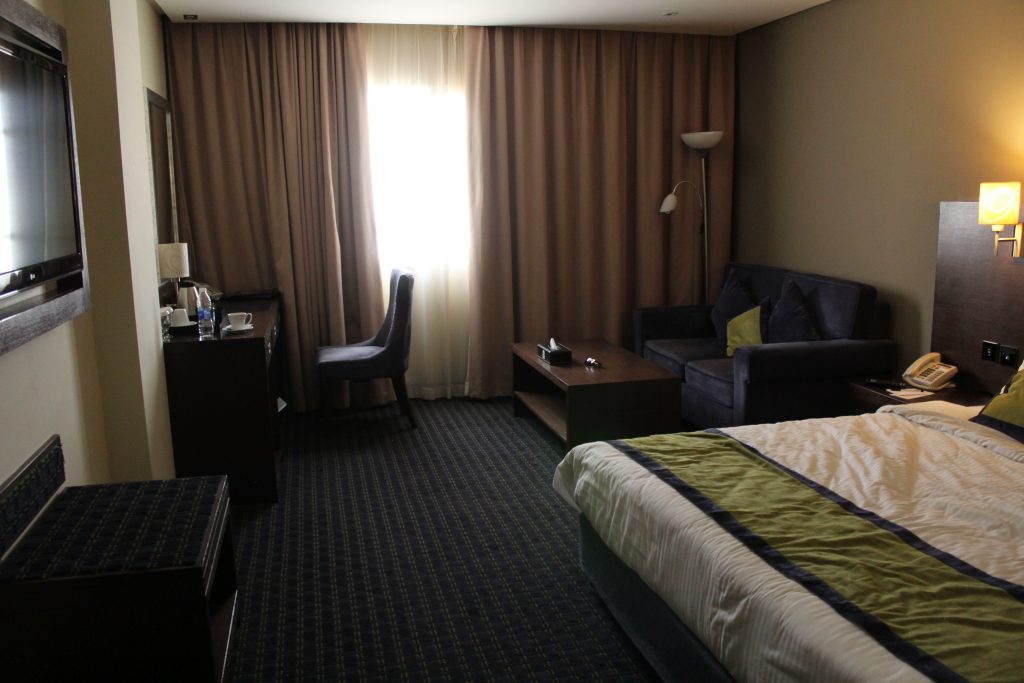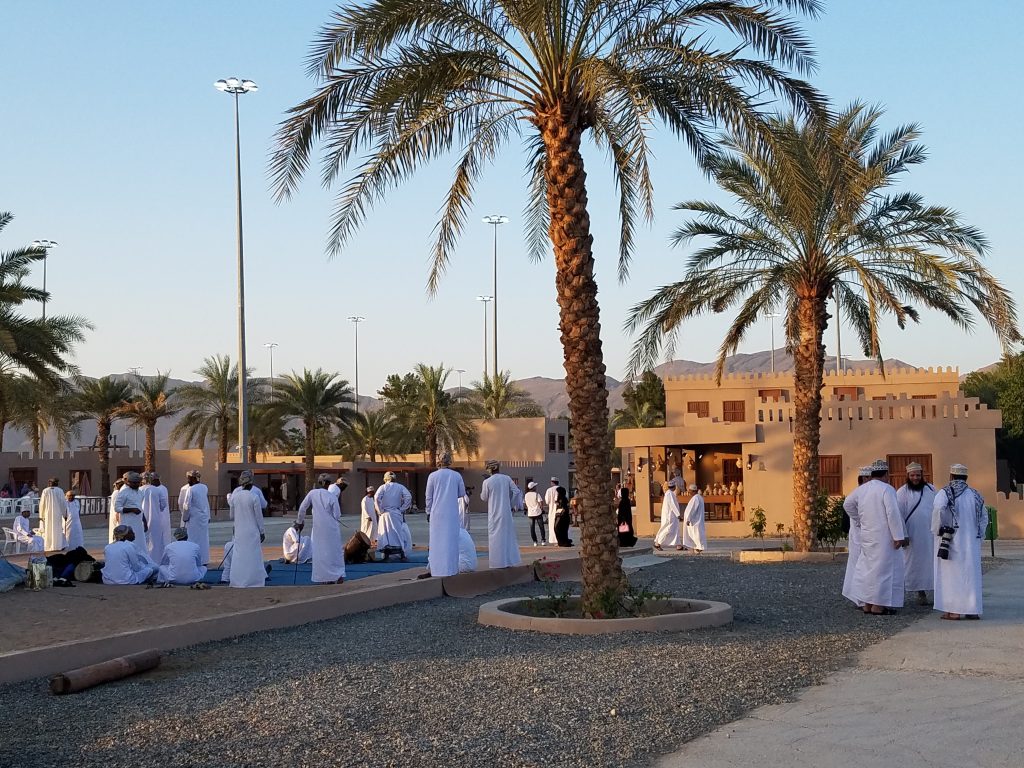After arriving from Bahrain on Oman Air grabbing a visa on arrival, and clearing immigration, I met my tour guide to begin my Muscat day tour. You can read more about my experience at Bahrain Airport and my very first flight on Oman Air here.
My guide, Sulaiman, from Majan Views tour company, was waiting for me with a sign in hand and we were ready to go start our Muscat day tour. I had found him on TripAdvisor a few weeks before my trip and negotiated a fair price for a full 0.5+1+1+0.5 = 3 days of activity. He said he had been waiting for about an hour, since my flight had been delayed (see more about that on my previous post here). We immediately started the tour from there, with a quick stop at my hotel (Best Western Premier Muscat) to check in and drop off my luggage. The room was about what you’d expect from a 3-star in a major city.

Muscat day tours – Best Western Premier Muscat
After some tea in the hotel room and a brief rest, I met Sulaiman outside for magical afternoon and evening on our Muscat day tour. It began with a drive through the commercial district, where the hotels are located, to the old city, Mutrah. We visited one of the Sultan’s six residences and I heard a little more about this mysterious figure from Sulaiman.

Al Alam Palace – Muscat day tour
The Omanis absolutely love the Sultan, Sultan Qaboos, who is an absolute ruler, with all power residing with him. However, he is a benevolent monarch, devoted to his country (and is said to be wedded in fact to his country), and is the longest serving ruler in the Arab world. As the only son, isolated by his father from participating in politics, he overthrew his father in a coup in 1970 with the help of some expatriate friends, and set to modernizing and unionizing the country. His first test was to put down an insurgency from Yemen, which he did with the help from Iran, Jordan, and the British. He set Oman on the course of progress, technology, end enlightenment – and in fact the day he took power (Jul 23) is a national holiday that is coined “Renaissance Day.”

Very little is known about Sultan Qaboos and his personal life, and he has no heirs. Given that he is 75 years old, the succession path should be clear but it is decidedly not. Sulaiman explained that when the Sultan dies, the military takes power for 3 days. In these 3 days, the ruling family try to choose a successor. If they cannot, then a letter signed by Qaboos naming his choice as air is opened and that named heir takes power. I asked Sulaiman if the Omanis trusted the military to hand power back and he said everyone trusts the military, because everyone has family in it. Notably, Oman was untouched by the Arab Spring.
People here are well off, which is why they probably love the Sultan and everything he has done for the country. There is free education through college. There is free land for every man over 24. There is a financial pension from the government for every man over 45. At the same time, young people are encouraged to work hard and prosper in their studies and industry. Tourism is beginning to boom and of course oil and gas has been for some time. They are a little late on the technology industry adoption curve, but Sulaiman says they’re trying. The large Indian and Pakistani presence in the country is certainly helping.
The Sultan has built many beautiful parks, mosques, and monuments around the country free for the people to enjoy. One is the Frankincense monument:

Another is the Grand Mosque, which I will explore tomorrow.
You can read more about the Sultan here. He is a fascinating figure, and the stuff Hollywood scripts is made of.
After learning about Sultan Qaboos and seeing the palace, we went to one of the ruins of a Portuguese fort which overlooked the bay of Muscat. Not only is the current place in history of Oman fascinating, but its history itself is a marvel. The Portuguese settled in Oman in the 15th century, and shared much of its knowledge of exploration and sea-faring with the Omanis, who were able to shadow them for several centuries through trade and cultural dissemination. Eventually the disciple surpassed the teacher. In 1698, Zanzibar (formerly held by the Portuguese) became part of the Omani “empire”, when the Omanis defeated the Portuguese in a battle in Mombassa. You can read more about Sultanate of Zanzibar here.





After the watch tower, we went to the Mutrah Suq. It was clean, cool, and surprisingly not crowded and without that usual pushy feel. Sulaiman mentioned this was by design – in fact, shop owners were told not to hassle guests to try to bring them to their store or look at merchandise. He said, however, that as more Pakistanis and Indians were taking over, this was changing.

Mutrah Suq – Muscat day tour
 There were a number of unique Omani items for sale in the Suq. The Kuma, the cap worn by the men, is very beautiful and also reflective of Oman’s African heritage. You can read more about Omani dress here. Also, the frankincense burners are apparently a big deal here – too bad that’s not one of my favorite smells!
There were a number of unique Omani items for sale in the Suq. The Kuma, the cap worn by the men, is very beautiful and also reflective of Oman’s African heritage. You can read more about Omani dress here. Also, the frankincense burners are apparently a big deal here – too bad that’s not one of my favorite smells!

Daggers – now ceremonial, are another famous local item still worn as ornamentation by men. Finally, dates, which I hope to bring back a bunch of to share with friends.
After the Mutrah Suq, we ended our Muscat day tour by heading to the Muscat Festival, a special event held annually in Jan and Feb that highlighted the cultural of Oman and also provided a carnival-like atmosphere for families. It was a 30 minute drive from the commercial center.

Muscat Festival
This was literally a one-stop shop for everything Omani in a few hours, perfect for a Muscat day tour! I couldn’t have arrived at a better time. I got to sample and learn about street food like Omani bread (with either egg, cheese or honey), samosa (typically baked or lightly fried, not deep fried) dates, sweets, and honey.



I got to listen to traditional song, dance, and music and see more dhows…


…and see Omanis in their traditional dress (which differed by region) practicing their traditional crafts and trades.



…and simply walk around and enjoy. It was really nice to see Omanis just going about their personal and family time, and it reminded me again that people are really the same everywhere.
I’ll leave you with this last sample of traditional Omani music and dance to end an amazing Muscat day tour. What a fascinating country!
